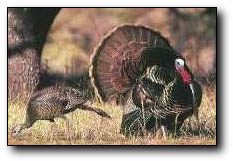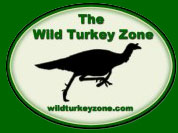|
Reproduction
 |
|
A gobbler
strutting for a hen
|
The increase of daylight
in spring triggers hormonal changes in wild turkeys.
The initiation of gobbling in late February to early
March signals the approach of the mating period. Gobbling
is used to attract receptive females for mating. Gobblers
are polygamous and will mate with several hens. Only
the most dominant gobblers do the majority of the
mating although subdominant gobblers and jakes will
sneak in and breed a few hens..
Gobbling begins before
sunrise while the gobbler is still on the roost. The
gobbler is hoping to attract as many hens as possible
before he flies down. It varies some but usually about
15 minutes before sunrise, the gobbler flies down
and begins his courtship display by strutting and
gobbling for the hen(s). Strutting begins with the
raising of body feathers, fanning of the tail, and
dropping the wings alongside to the ground. Blood
rushes to the gobbler's head, and his snood elongates
and his caruncles turn a bright red. If the hen is
receptive, she will crouch before the displaying gobbler
and they will mate. A single mating is sufficient
to fertilize all eggs, but hens usually mate several
times.
 Once
the mating season is fully underway, hens seek out
nesting areas to lay eggs. Laying generally begins
in late March to early April through most of the country.
Turkeys usually nest in areas (old fields, cutovers,
pine forests, stream edges) with a well-developed
under story that provides some bushy/vine concealment.
One egg is laid daily until a clutch averaging 9 to
11 eggs is completed. Incubation takes 28 days, and
all poults hatch within a 24-hour period. Depending
on weather, the brood hen and poults leave the nest
within 24 hours of hatching. Peak hatching period
is from about May 20 to June 10. If the first nest
is destroyed, some hens attempt a second nest. Hens
that have to re-nest lay fewer eggs. Once
the mating season is fully underway, hens seek out
nesting areas to lay eggs. Laying generally begins
in late March to early April through most of the country.
Turkeys usually nest in areas (old fields, cutovers,
pine forests, stream edges) with a well-developed
under story that provides some bushy/vine concealment.
One egg is laid daily until a clutch averaging 9 to
11 eggs is completed. Incubation takes 28 days, and
all poults hatch within a 24-hour period. Depending
on weather, the brood hen and poults leave the nest
within 24 hours of hatching. Peak hatching period
is from about May 20 to June 10. If the first nest
is destroyed, some hens attempt a second nest. Hens
that have to re-nest lay fewer eggs.
Generally, less than
half of all nesting attempts are successful. The fact
that wild turkeys nest on the ground and require a
total of 6 weeks to lay and incubate eggs makes hens
and their nests vulnerable to predation and human
disturbance (destroying nests by burning, mowing,
and discing). Common predators of turkey eggs include
raccoons, skunks, opossums, crows, and snakes. Mortality
rates of poults generally range from 70 to 80 percent
or higher, especially during their first 2 weeks of
life, when they are unable to fly and roost under
the hen on the ground.
Poult predators include
mammals of which raccoon and bobcats cause the greatest
loss. Foxes and coyotes are also important predators.
Birds caused 13 percent and reptiles were responsible
for 4 percent of the loss. Feral dogs and cats also
will prey on hens/eggs when the opportunity arises.
Fortunately, turkeys have a high reproductive potential,
and one good hatch can significantly increase populations
and offset previous poor hatches.
|

